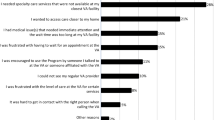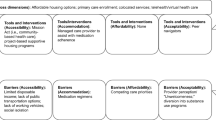Abstract
BACKGROUND: Women veterans are generally less healthy than their nonveteran female counterparts or male veterans. Accumulating evidence suggests there may be barriers to women veterans’ access to and use of Veterans Health Administration (VHA) care.
OBJECTIVE: To document perceived and/or actual barriers to care in a nationally representative sample of women veterans and examine associations with VHA use.
DESIGN: Cross-sectional telephone survey.
PARTICIPANTS: Women who are current and former users of VHA from VA’s National Registry of Women Veterans.
MEASUREMENTS: Assessments of perceptions of VHA care, background characteristics, and health service use.
RESULTS: Perceptions of VHA care were most positive regarding facility/physical environment characteristics and physician skill and sensitivity and least positive regarding the availability of needed services and logistics of receiving VHA care (M=0.05 and M=−0.10; M=−0.23 and M=−0.25, respectively). The most salient barrier to the use of VHA care was problems related to ease of use. Moreover, each of the barriers constructs contributed unique variance in VHA health care use above and beyond background characteristics known to differentiate current users from former VHA users (Odds ratio [OR]=4.03 for availability of services; OR=2.63 for physician sensitivity and skill: OR=2.70 for logistics of care; OR=2.30 for facility/physical environment). Few differences in barriers to care and their association with VHA health care use emerged for women with and without service-connected disabilities.
CONCLUSIONS: Findings highlight several domains in which VHA decisionmakers can intervene to enhance the care available to women veterans and point to a number of areas for further investigation.
Similar content being viewed by others
References
Skinner KM, Sullivan LM, Tripp TJ, et al. Comparing the health status of male and female veterans who use VA health care: results from the VA women’s health project. Women Health. 1999;29:17–33.
Skinner KM, Furey J. The focus on women veterans who use Veterans Administration health care: the Veterans Administration women’s health project. Mil Med. 1998;163:761–6.
Skinner KM. The VA women’s health project: identifying the health care needs of women veterans. Forum: VA Health Services Research and Development. 2000:6.
Furey J. Changing role of women veterans raises issues about health care service delivery. Forum: VA Health Services Research and Development. 2000:6.
Skinner KM, Kressin N, Frayne S, et al. The prevalence of military sexual assault among female Veterans Administration outpatients. J Interpersonal Violence. 2000;3:289–304.
Surís A, Lind L, Kashner M, Borman PD, Petty F. Sexual assault in women veterans: an examination of PTSD risk, health care utilization, and cost of care. Psychosom Med. 2004;66:749–56.
Weiss TW. Improvements in VA health services for women veterans. Women Health. 1995;23:1–12.
Turpin RS, Darcy LA, Weaver FM, Kruse K. Assessing health care delivery to male versus female veterans. Women Health. 1992;18:81–95.
Yano EM, Washington DL, Goldzweig C, Caffrey C, Turner C. The organization and delivery of women’s health care in Department of Veterans Affairs medical center. Women’s Health Issues. 2003;13:55–61.
Washington DL, Caffrey C, Goldzweig C, Simon B, Yano EM. Availability of comprehensive women’s health care through Department of Veterans Affairs medical center. Women’s Health Issues. 2003;13:50–4.
Kressin NR, Skinner K, Sullivan L, et al. Patient satisfaction with Department of Veterans Affairs health care: do women differ from men? Mil Med. 1999;164:283–8.
Miller PM, King LA, Wolfe J, King DW. Gender ideology, sensitivity, and knowledge: a model of gender awareness in VA health care. Veterans Health Syst J. 1999;4:27–30.
Bean-Mayberry B, Chang C, McNeil M, Hayes P, Scholle SH. Comprehensive care for women veterans: indicators of dual use of VA and non-VA providers. J Am Med Women’s Assoc. 2004;59:192–7.
Schuler MP, Barclay AG, Harrison B, Larson P. Psychological services offered to female veterans. J Clin Psychol. 1986;42:668–75.
Kazis LE, Miller DR, Clark J, et al. Health-related quality of life in patients served by the Department of Veterans Affairs: results from the Veterans Health Study. Arch Intern Med. 1998;158:626–32.
Washington DL. Challenges to studying and delivering care to special populations: the example of women veterans. J Rehabil Res Dev. 2004;41:7–9.
Wolfe J, Stern A, Daley J, Zaslavsky A, Roper SF, Wilson K. Changing demographic characteristics of women veterans: results from a national sample. Mil Med. 2000;165:773–80.
Department of Veterans Affairs. Disabled veterans get health care priority from VA. Available at: http://wwwl.va.gov/opa/pressrel/PressArt-Internet.cfm?id=715. Accessed June 24, 2005.
Department of Veterans Affairs. VA announces record budget, health care changes. Available at: http://wwwl.va.gov/visns/visn03/newsletter/pr11703.asp. Accessed June 24, 2005.
Melnyk KAM. Barriers: a critical review of recent literature. Nurs Res. 1988;37:196–201.
Neri MT, Kroll T. Understanding the consequences of access barriers to health care: experiences of adults with disabilities. Disabil Rehabil. 2003;25:85–96.
Scheer J, Kroll T, Neri MT, Beatty P. Access barriers for persons with disabilities: a consumer’s perspective. J Disabil Policy Stud. 2003;13:221–30.
Ouimette P, Wolfe J, Daley J, Gima K. Use of VA health care services by women veterans: findings from a national sample. Women Health. 2003;38:77–91.
Fiscella K, Franks P, Clancy CM, Doescher MP, Banthin JS. Does skepticism towards medical care predict mortality? Med Care. 1999;37:409–14.
Rosenheck R, Stolar M. Access to public mental health services: determinants of population coverage. Med Care. 1998;36:503–12.
Holm CJ, Frank DI, Curtin J. Health beliefs, health locus of control, and women’s mammography behavior. Cancer Nurs. 1999;22:149–56.
Salgado DM, Vogt DS, King LA, King DW. Gender Awareness Inventory-VA: a measure of ideology, sensitivity, and knowledge related to women veteran’s health care. Sex Roles. 2002;46:247–62.
Vogt DS, Stone ER, Salgado DM, King LA, King DW, Savarese VW. Gender awareness among Veterans Administration health care workers: existing strengths and areas for improvement. Women Health. 2001;34:65–83.
Yeung RYT, Leung GM, McGhee SM, Johnston JM. Waiting time and doctor shopping in a mixed medical economy. Health Econ. 2004;13:1137–44.
Damron-Rodriguez J, White-Kazemipour W, Washington D, Villa VM, Dhanani S, Harada ND. Accessibility and acceptability of the department of veteran affairs health care: diverse veterans’ perspectives. Mil Med. 2004;169:243–50.
Ware JE, Snow KK, Kosinski M, Gandek B. SF-36 Health Survey: manual & interpretation, The Health Institute, New England Medical Center, Boston, 1993;3–13.
Stern A, Wolfe J, Daley J, Zaslavsky A, Roper SF, Wilson K. Changing demographic characteristics of women veterans: results from a national sample. Mil Med. 2000;165:773–80.
STATA 7.0. College Station, TX STATA Corporation, 1999.
Author information
Authors and Affiliations
Corresponding author
Additional information
This research was supported by a Department of Veterans Affairs Health Services Research and Development Award to Jessica Wolfe and Jennifer Daley, SDR 93–102, and support from the National Center for PTSD, Department of Veterans Affairs,
Guarantor: Dawne Vogt, PhD.
Rights and permissions
About this article
Cite this article
Vogt, D., Bergeron, A., Salgado, D. et al. Barriers to veterans health administration care in a nationally representative sample of women veterans. J GEN INTERN MED 21 (Suppl 3), S19–S25 (2006). https://doi.org/10.1111/j.1525-1497.2006.00370.x
Published:
Issue Date:
DOI: https://doi.org/10.1111/j.1525-1497.2006.00370.x




